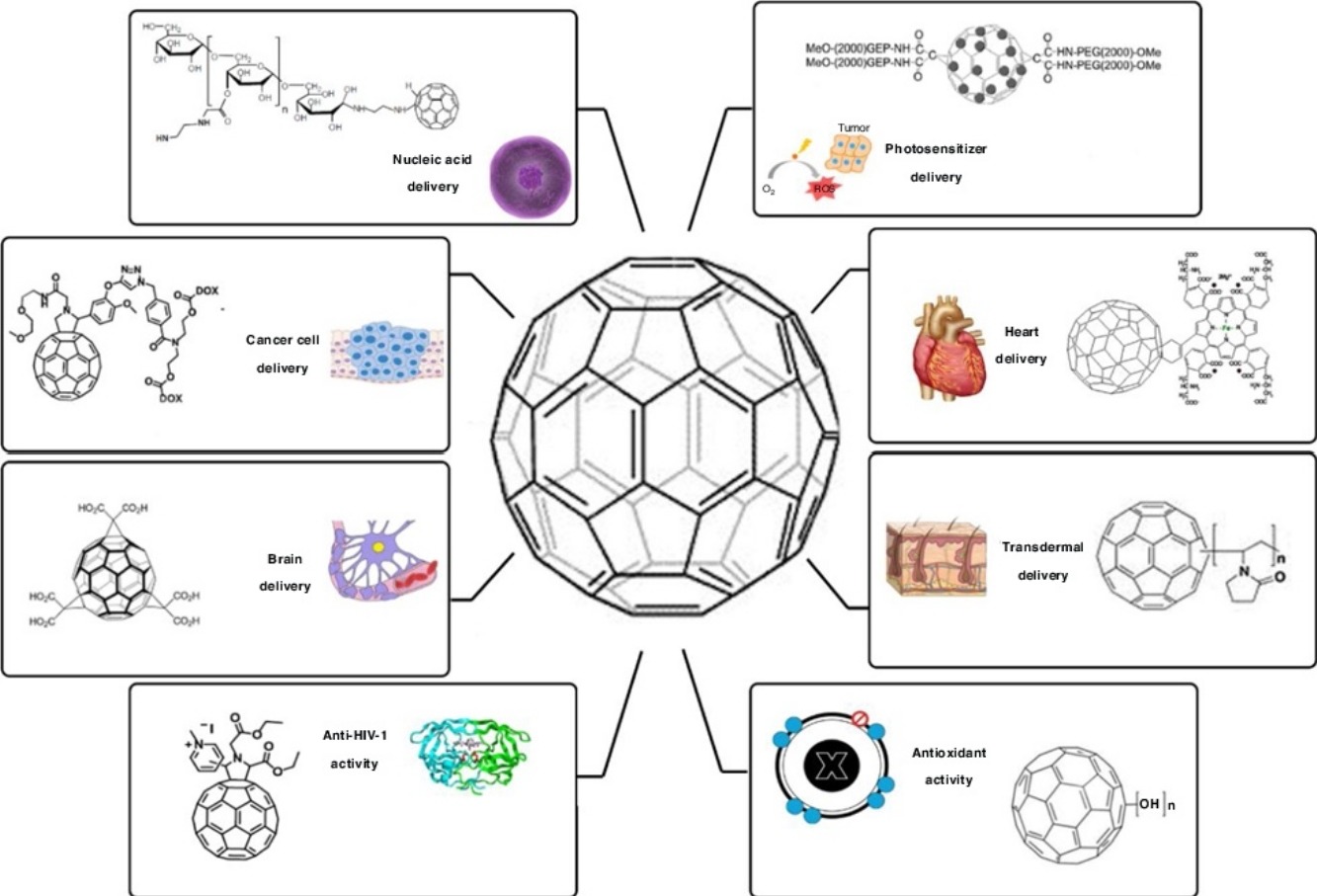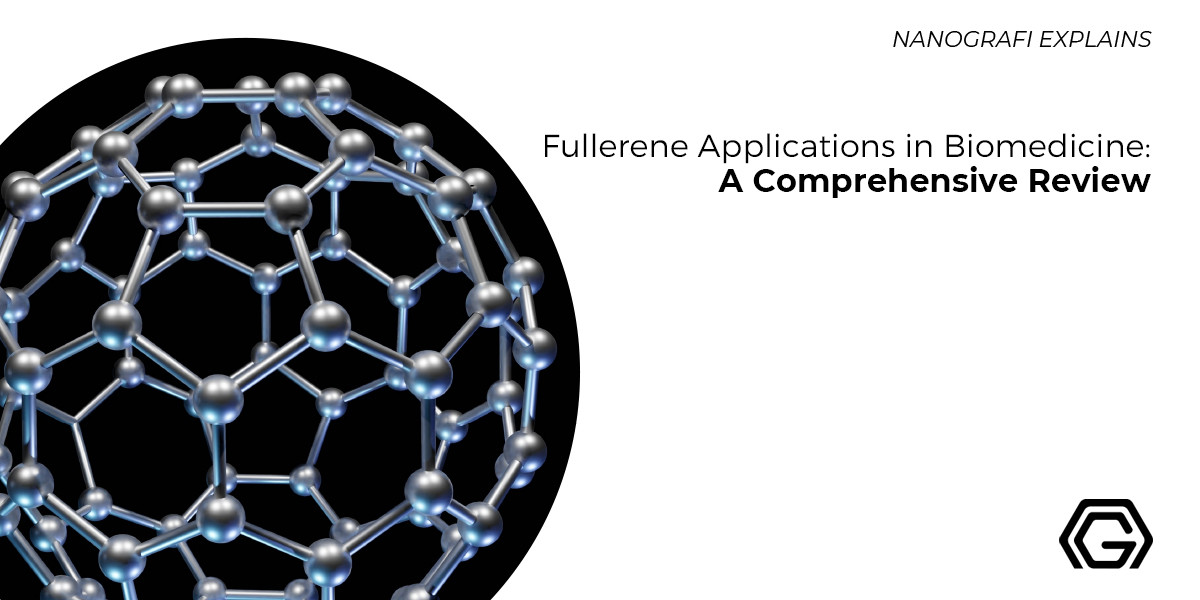Application of Fullerene in Medicine - Nanografi
Fullerene plays a significant role in medicine due to its diverse applications and unique properties. As an active molecule, Fullerene exhibits versatility in various therapeutic areas.
One of the primary uses of Fullerene in medicine is its application as an antioxidant. Its high electron affinity allows Fullerene to easily react with radicals, providing potent antioxidant effects. Consequently, Fullerene is utilized as an anti-aging and anti-damage agent in the cosmetic industry. Moreover, Fullerene's distinctive molecular structure, antioxidant properties, and biological compatibility make it an effective antiviral agent. These attributes enable Fullerene to combat viruses by targeting their unique molecular structures and exhibiting antiviral activity. This multifaceted functionality positions Fullerene as a valuable component in medical treatments and research. At Nanografi, we strongly believe that Fullerene exhibits remarkable properties that have the potential to revolutionize various medical applications. To reach high-quality Fullerene products, visit Nanografi and take your business and projects to new heights.
Introduction
Fullerene has extensive potential applications across multiple industries including electronics, energy, medicine and others, leading to a growing market demand. Furthermore, as nanotechnology and materials science continue to advance, the utilization and demand for products based on fullerene are anticipated to rise in the future. In the medical field, fullerenes have found wide-ranging use in various applications such as gene and drug delivery, photodynamic therapy, X-ray imaging contrast agents, and high-performance MRI contrast agents. These applications of fullerenes have been extensively documented and reviewed in various sources.
The Potential and Current Applications of Fullerene in Medicine
Extensive research has been carried out to investigate the biomedical applications of Fullerene since its discovery. In particular, studies from 2003 onwards have explored the potential use of Fullerene in medicine. These investigations have demonstrated its remarkable ability to bind specific antibiotics, effectively targeting drug-resistant bacteria. Additionally, Fullerene has shown promising selectivity towards certain cancer cells, including melanoma. A notable publication in Chemistry & Biology highlighted Fullerene's role as a light-activated antimicrobial agent, highlighting its potential in combating diverse pathogens.
Fullerene as Photosensitizers in Medical Application
Another potential medical application of fullerenes is their photoexcitation process. When exposed to light, fullerene molecules can be excited from their ground state to 1C60. Through intersystem crossing, this short-lived 1C60 species can be efficiently converted into a longer-lived state known as 3C60. In the presence of oxygen, fullerene can decay from its triplet state to the ground state, transferring its energy to oxygen and generating highly cytotoxic singlet oxygen (1O2). Additionally, fullerene can transfer one electron in the presence of oxygen, forming a hydroxyl radical (-OH) and a superoxide anion radical (O2•-). Furthermore, the high-energy species 3C60 and 1C60 exhibit remarkable electron acceptor properties and can be readily reduced to C60 in the presence of an electron donor. Overall, this photoexcitation process of fullerenes presents various intriguing possibilities for medical applications.
For further insight on Fullerene and its applications, you can Check out our blogpost here.
Fullerene in Tumor Research
Fullerene is a crucial component that warrants investigation in cancer research, particularly in the context of photodynamic therapy, which is considered a more significant therapeutic approach than radiation therapy.In recent cancer experiments, HeLa cells have been widely utilized, and novel photosensitizers have been developed to enhance their absorption by cancer cells and induce cell death. To minimize undesired cellular damage, the photosensitizer has a limited duration of stay in the body. Notably, fullerenes have demonstrated potential for absorption by HeLa cells when specifically designed for this purpose, utilizing functional groups such as L-arginine, folic acid, and L-phenylalanine to deliver C60 derivatives to the cells.

Mechanism of Functionalizing Fullerene in Cancer Cells
Fullerenes are functionalized to enhance their solubility in cancer cells. These molecules are taken up by cancer cells at an increased rate due to upregulated transporters. Specifically, fullerenes with functional groups such as L-phenylalanine and L-arginine are transported into the cells by amino acid transporters. Once inside the cells, C60 derivatives react to light radiation, converting molecular oxygen into reactive oxygen species, thereby inducing apoptosis in cancer cells, including HeLa cells and other cancer cells capable of absorbing fullerene molecules.Reducing damage to surrounding tissues during treatment, this research demonstrates the targeted effect of reactive substances on cancer cells, triggered by light radiation.
Fullerene in Drug and Gene Delivery
The direct intracellular delivery of biomolecules and drugs has emerged as a prominent area of research, prompting efforts to develop effective and safe carriers for this purpose. According to researchers in 2005, there are four main categories of gene and drug carriers: inorganic nanoparticles, recombinant proteins, viral carriers, and organic cationic compounds. Nanoparticles are widely used as carriers for cellular delivery due to their advantageous properties such as controlled drug release, targeted delivery, and biocompatibility. Fullerenes belong to the class of inorganic nanoparticles and are commonly used due to their biological activity and small size (1nm). The various biological activities exhibited by fullerene, which is an allotrope of carbon, are determined by the characteristics of its core and the chemical modifications applied to the core.

Conclusion
Fullerene has shown significant potential in various industries, including medicine, due to its unique properties and versatile applications. Extensive research has been conducted to explore its biomedical applications, particularly in gene and drug delivery, photodynamic therapy, and cancer research. Fullerene's ability to enhance solubility, selectively target cancer cells, and induce apoptosis has been demonstrated, making it a promising candidate for advanced medical treatments. Furthermore, the photoexcitation process of fullerenes presents intriguing possibilities for medical applications, such as generating reactive oxygen species and acting as electron acceptors. Overall, Fullerene offers substantial potential for advancing medical research and enhancing therapeutic approaches in the future. In summary, ullerene holds great promise in advancing medical research and improving therapeutic strategies in the future. Nanografi enhances your projects through the production and provision of cutting-edge technology materials. Opt for Nanografi to take advantage of our expertise and inventive approaches.
References
Application of Fullerene in Medicine - Nanografi - Nanografi Nano Technology. (n.d.). Retrieved March 5, 2024, from https://nanografi.com/blog/application-of-fullerene-in-medicine-nanografi-/
Fullerene Applications in Biomedicine: A Comprehensive Review - Nanografi - Nanografi Nano Technology. (n.d.). Retrieved March 5, 2024, from https://nanografi.com/blog/fullerene-applications-in-biomedicine-a-comprehensive-review-nanografi/
HeLa - Wikipedia. (n.d.). Retrieved March 5, 2024, from https://en.wikipedia.org/wiki/HeLa
Kazemzadeh, H., & Mozafari, M. (2019). Fullerene-based delivery systems. Drug Discovery Today, 24(3), 898–905. https://doi.org/10.1016/J.DRUDIS.2019.01.013
Shi, J., Wang, B., Wang, L., Lu, T., Fu, Y., Zhang, H., & Zhang, Z. (2016). Fullerene (C60)-based tumor-targeting nanoparticles with “off-on” state for enhanced treatment of cancer. Journal of Controlled Release, 235, 245–258. https://doi.org/10.1016/J.JCONREL.2016.06.010
Recent Posts
-
Advanced Materials for Unmanned Aerial Vehicle (UAV) Protection Against Laser
Consider a UAV on a critical mission, rendered inoperative by a sudden laser attack. With the increa …26th Jul 2024 -
Simulation and Modeling of Material Properties
Our world is composed of a dazzling array of materials, each with its own unique properties that dic …19th Jul 2024 -
Advanced Coatings for Superior Corrosion and Wear Resistance
Corrosion and wear pose significant challenges across various industries, leading to substantial eco …12th Jul 2024







